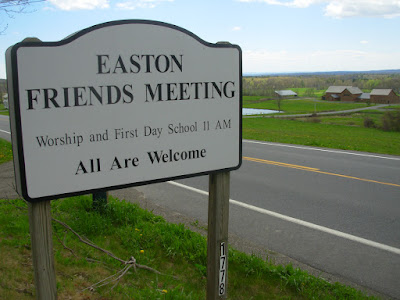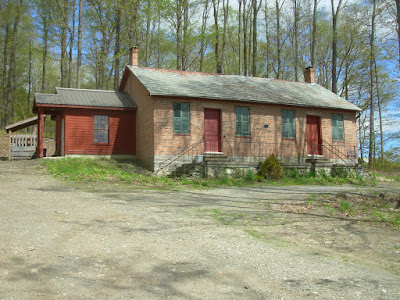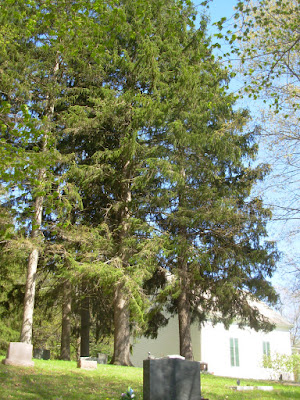"God's Architecture" was the name of a tour of five Washington County churches held on Saturday, May 14. The event was a fundraiser for the Washington County Historical Society with trustee William Krattinger sharing his research on each building. I wish I could have gone on it and given you a report. Unfortunately, hay got in my way. May is the busiest month for farmers. Most other activities, tours and blogging included, take a backseat.
But there's a bright side?! to this farming frenzy. Things break. Which means you have to get parts. Which entails a trip to Washington County where the equipment dealerships are located. I was heading down Rt. 40 on just such a trip, thinking it was silly to waste all this time and gas on a flat tire (or was it a dead battery? a blown hydraulic hose? - all the minor disasters begin to blur over time). Why not have a little fun by exploring two of the churches that had been on the tour itinerary? Without an expert guide on their history I focused mostly on features of their natural setting - "God's Architecture" of another sort. Here's a little of what I found.

My first stop was the North Quaker Meetinghouse. It's located on the east side of Rt. 40 about three miles south of Middle Falls. Look for a sign and a small brick building sitting in the woods. Both this and the South Meetinghouse are simple dignified structures in keeping with Quaker tradition. They were built by early settlers to the Town of Easton. Curiously, several of these pioneers were retired sea captains from Nantucket. Today the structures are used by the Society of Friends, with the North hosting services thru the winter and the South being used in the warmer months.

The first thing you notice at the North Meetinghouse is the view. It's one of the most expansive panoramas in all of Washington County, featuring three of New York State's mountain ranges. To the southwest are the high peaks of the Catskills. Directly west, the low ridges of the southern Adirondacks form the horizon. Immediately south is a line of hills that mark the front edge of the Taconics, including Willard Mountain which lies midway between the two meetinghouses.
In an interesting coincidence, both buildings sit almost directly on top of the Taconic Frontal Thrust, where slates and mudstones from the east were pushed on top of continental shelf rocks some 450 million years ago. A little bit of that old continental shelf lies beneath the North Meetinghouse. It's part of a limestone/dolostone "sliver", five or six miles long, that is exposed from just north of Bald Mountain, down thru Middle Falls to the vicinity of the North Meetinghouse. It was broken off by the overthrusting rocks during the Taconic Orogeny. This has long been, and still is extensively quarried. It's also one of the best places in Washington County to see fossils. Look towards the north end of the roadside ledge near the meetinghouse (across from the large pull-off) to see the impressions of small brachiopods that lived in a tropical sea some 500 million years ago.

As you look west across Rt. 40 the land drops away in a mosaic of fields and woodlots. This is the Hudson Valley - one segment of a long tectonic depression along the eastern margin of North America. It has filled with soft shale from sediments eroded off the once mighty Taconics. The Hudson River is about two miles away although you can't see it from this vantage.
About 13,000 years ago the North Meetinghouse would have been water front property. A cold, muddy post-glacial lake with chunks of ice floating in it lapped the shore. Eventually the lake drained but the highest strand line was right at the meetinghouse's doorstep.
Glacial tills formed the soils on the higher ground to the east while lacustrine clays and silts filled the valley. Remnants of the Battenkill's sandy delta are intermingled with the clay soils. Today Flately Brook collects runoff from this area and channels it into the Hudson.
Flately Brook
Limestone often makes for lush plant growth by sweetening the soil and freeing up nutrients. The North Meetinghouse sits amongst a woods of mostly sugar maples. There are a few oaks here as well and some tall, deeply furrowed trees that weren't leaved out when I stopped so I'm not sure what they are. A Northern Hardwood Forest would be the expected ecological community but with over 400 years of human activity - logging, pasturing, etc. - intact natural ecosystems are hard to find. This being the "banana belt" of Washington County, one expects to see more southerly trees like oaks and hickories. In a short walk I didn't see as many wildflowers as I'd hoped for. Ubiquitous garlic mustard (an invasive) along with clumps of Mayapple and some violets were about it.
Before you leave take a look at the front entrance of the building. Here you'll see slate steps, a marble threshold, limestone foundation stones and bricks made of clay - a geological smorgasbord.
It's a scenic five mile drive south on Rt. 40 from the North Meetinghouse to Easton where you take a left on Grove Road to Meetinghouse Road. Enjoy the historic and interesting architecture of Easton and Barkers Grove before heading up the hill to the South Meetinghouse. This white clapboard structure is a little more imposing, although still quite plain compared to many churches. Along side it is the Easton Rural Cemetery and a striking grove of spruce trees.
This site is also at the very edge of the Taconics with Beadle Hill rising to the southeast. The knoll that the South Meetinghouse and cemetery sit on lies between two branches of McAuley Brook. In back of the building there's a pond/wetland complex. It looks to be great wildlife habitat.
McAuley Brook
The mowed and shaded lawn hosts several low, ground-hugging flowers. I saw violets and strawberries, ground phlox and ivy, pussytoes, dandelions and the unavoidable garlic mustard. Various mosses fill in bare spots in the dry soil. There is a row of old sugar maples along the road and a few nut trees as well (butternuts?). But it's the huge spruces that dominate the site. Some must approach 100 feet tall and they are so thick that no sunlight reaches the ground. There are a few white pines and hemlocks but this appears to be a planted, almost pure stand of spruce. If anyone knows its history I'ld love to hear about it.

While you're exploring, take a look at the gravestones. Many of the older ones are marble that has been weathered to the point that it is hard to read the inscriptions. The calcite of the rock reacts with acidity in rain to slowly dissolve. Marble is metamorphosed limestone with the most common source being the Valley of Vermont to the east of here. You can also find marbles in the Adirondacks and northern Washington County.

Newer stones tend to be cut from granite. This igneous rock stands up to weathering better. Look closely to see the individual minerals of feldspar, quartz and biotite. Various combinations of these and other minerals result in a pleasing array of colors and textures. Some stones have been left rough, others are highly polished. Barre, Vermont has long been a nearby source for granite. In Washington County, a recent resurgence in quarrying along the Rt. 4 corridor between Fort Ann and Whitehall has resulted in rock being marketed as granite but this is metamorphic terrain with gneiss being the most common rock.
I hope you enjoyed this short visit to the Easton Meetinghouses. It's inspiring to see people and nature working together to create such lovely spots. Nature has been working on my hay fields too and it's about time I got out there and did my part. Enough blogging, back to work.
More -
Easton Friends Meeting
information.
Easton Library page on
Quakers.
Washington County Historical Society
site.
